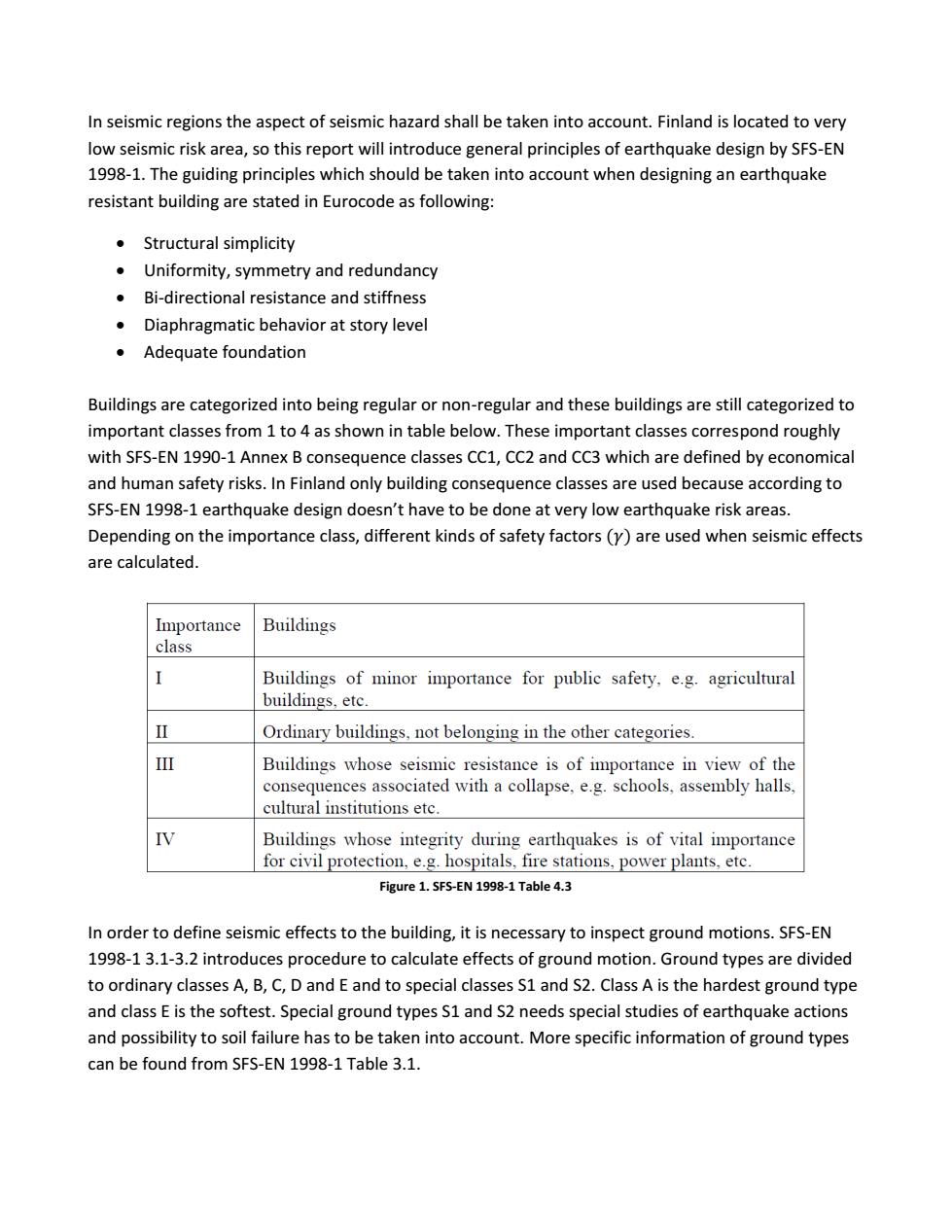正在加载图片...

In seismic regions the aspect of seismic hazard shall be taken into account.Finland is located to very low seismic risk area,so this report will introduce general principles of earthquake design by SFS-EN 1998-1.The guiding principles which should be taken into account when designing an earthquake resistant building are stated in Eurocode as following: Structural simplicity Uniformity,symmetry and redundancy Bi-directional resistance and stiffness Diaphragmatic behavior at story level Adequate foundation Buildings are categorized into being regular or non-regular and these buildings are still categorized to important classes from 1 to 4 as shown in table below.These important classes correspond roughly with SFS-EN 1990-1 Annex B consequence classes CC1,CC2 and CC3 which are defined by economica and human safety risks.In Finland only building consequence classes are used because according to SFS-EN 1998-1 earthquake design doesn't have to be done at very low earthquake risk areas. Depending on the importance class,different kinds of safety factors(y)are used when seismic effects are calculated. Importance Buildings class I Buildings of minor importance for public safety.e.g.agricultural buildings.etc. Ordinary buildings.not belonging in the other categories. 分 Buildings whose seismic resistance is of importance in view of the consequences associated with a collapse.e.g.schools.assembly halls. cultural institutions ete. N Buildings whose integrity during earthquakes is of vital importance for civil protection.e.g.hospitals.fire stations.power plants.ete. Figure1.SFS-EN1998-1Table4.3 In order to define seismic effects to the building,it is necessary to inspect ground motions.SFS-EN 1998-13.1-3.2 introduces procedure to calculate effects of ground motion.Ground types are divided to ordinary classes A,B,C,D and E and to special classes S1 and S2.Class A is the hardest ground type and class E is the softest.Special ground types$1 and 52 needs special studies of earthquake actions and possibility to soil failure has to be taken into account.More specific information of ground types can be found from SFS-EN 1998-1 Table 3.1. In seismic regions the aspect of seismic hazard shall be taken into account. Finland is located to very low seismic risk area, so this report will introduce general principles of earthquake design by SFS-EN 1998-1. The guiding principles which should be taken into account when designing an earthquake resistant building are stated in Eurocode as following: Structural simplicity Uniformity, symmetry and redundancy Bi-directional resistance and stiffness Diaphragmatic behavior at story level Adequate foundation Buildings are categorized into being regular or non-regular and these buildings are still categorized to important classes from 1 to 4 as shown in table below. These important classes correspond roughly with SFS-EN 1990-1 Annex B consequence classes CC1, CC2 and CC3 which are defined by economical and human safety risks. In Finland only building consequence classes are used because according to SFS-EN 1998-1 earthquake design doesn’t have to be done at very low earthquake risk areas. Depending on the importance class, different kinds of safety factors are used when seismic effects are calculated. Figure 1. SFS-EN 1998-1 Table 4.3 In order to define seismic effects to the building, it is necessary to inspect ground motions. SFS-EN 1998-1 3.1-3.2 introduces procedure to calculate effects of ground motion. Ground types are divided to ordinary classes A, B, C, D and E and to special classes S1 and S2. Class A is the hardest ground type and class E is the softest. Special ground types S1 and S2 needs special studies of earthquake actions and possibility to soil failure has to be taken into account. More specific information of ground types can be found from SFS-EN 1998-1 Table 3.1